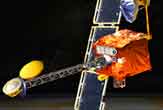

 Unlike the 2 previous Mars missions, NASA's latest Mars-bound spacecraft is on track for the Red Planet. The Mars Odyssey, which launched earlier this year and is set to arrive on October 23 (2 days before the Windows Experience Launch), is currently about a third of a way to its destination in Mars orbit.
Unlike the 2 previous Mars missions, NASA's latest Mars-bound spacecraft is on track for the Red Planet. The Mars Odyssey, which launched earlier this year and is set to arrive on October 23 (2 days before the Windows Experience Launch), is currently about a third of a way to its destination in Mars orbit.
"The Odyssey is working very, very well," said spacecraft manager Roger Gibbs. "Hopefully that will continue, and we’re preparing for the next phase of the mission."
The 2 previous Mars missions were claimed lost lost in 1999, with the Mars Climate Observer said lost due to a navigation error introduced by a metric-to-English units snafu, and the Mars Polar Lander said lost as a result of trouble with a lander leg.
The Mars Odyssey is set to add to the understanding of Mars' atmosphere. Big swings in the temperature at Mars mean the Martian atmosphere' varies greatly in density and height. JPL scientists currently are trying to estimate those conditions using data from the Viking and Mars Global Surveyor missions (the latter spacecraft is still collecting data and orbiting Mars).
"It’s very true that our mission success depends on our understanding the weather around Mars," Gibbs said.
If successful, Odyssey will eventually settle into observation at 250 miles (400 km) above the surface. From this height, three kinds of spectrometers on Odyssey will gather information to clarify the geographical history, distribution of minerals and elements, and types and strengths of radiation on the planet.
"Looking at what we had to do to get this relatively small, robotic spacecraft to Mars, (putting a human on Mars) is a very large and significant endeavor," Gibbs said.
One spectrometer, called the Thermal Emission Imaging System, or Themis, will take measurements of the infrared spectrum, giving a higher resolution picture of the surface of Mars than is available from Mars Global Surveyor.
The Gamma Ray Spectrometer, or GRS, will look at Mars in the Gamma ray spectrum to find how basic elements are distributed on the surface. In particular, it will search for hydrogen. Plaut said that hydrogen would most likely indicate the presence of water ice on, or just below, the surface.
"We know that there are H2O molecules at Mars," Plaut said, referring to findings from the past year in which Global Surveyor images showed evidence of recent water at Mars. Water would be an indicator that life existed at one time on the planet.
The final spectrometer, the Mars Radiation Environment Experiment, or MARIE, will measure particle radiation that may be a hazard to future astronauts.